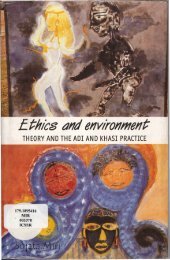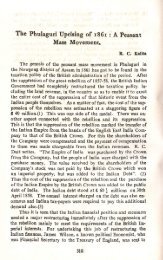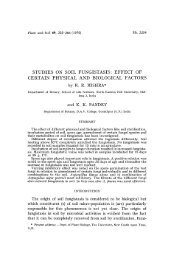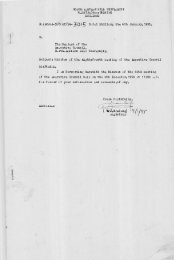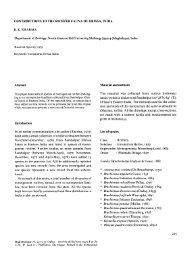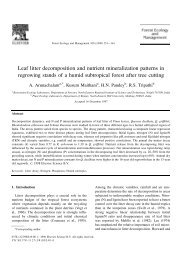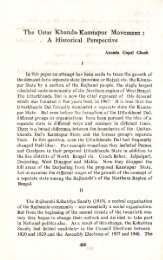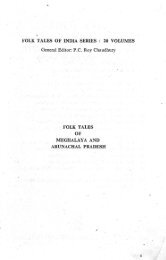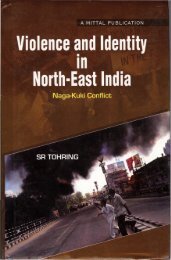Reorganisation of NE India Since 1947.pdf - DSpace@NEHU ...
Reorganisation of NE India Since 1947.pdf - DSpace@NEHU ...
Reorganisation of NE India Since 1947.pdf - DSpace@NEHU ...
You also want an ePaper? Increase the reach of your titles
YUMPU automatically turns print PDFs into web optimized ePapers that Google loves.
6 Reorganization <strong>of</strong> North-East <strong>India</strong> <strong>Since</strong> 1947<br />
Under the Government <strong>of</strong> <strong>India</strong> Act, 1935, the administration<br />
<strong>of</strong> hill areas <strong>of</strong> the province <strong>of</strong> Assam were classified into Excluded<br />
and Partially Excluded Areas, Excluded Areas remaining with<br />
Governor <strong>of</strong> Assam exercising power in his discretion without<br />
ministerial advice. The initiative in all legislative and executive<br />
acts in the Partially Excluded Areas lay with the Provincial<br />
Ministers, but the Governor <strong>of</strong> Assam had a special responsibility<br />
acting in his individual judgement in this field.<br />
With the coming <strong>of</strong> the Constitution <strong>of</strong> <strong>India</strong> in 1950, the tribal<br />
areas <strong>of</strong> north-east <strong>India</strong> were placed in two parts, A and B in the<br />
Table appended to the Sixth Schedule to the Constitution. In the<br />
part A, the United Khasi and Jaintia Hills District, the Garo Hills<br />
District, the Naga Hills District, the North-Cachar Hills and the<br />
Mikir Hills District were placed. The North-East frontier Tracts<br />
including Balipara Frontirer Tract, Tirap Frontier Tract, Abor<br />
Hill and Mishmi Hills and the Naga Hills Tribal Areas were<br />
categorised in Part B . Part A areas formed the Autonomous<br />
Districts and were administered by the Government <strong>of</strong> Assam<br />
with the Autonomous District Councils established in 1952 except<br />
in Naga Hills District. The Governor <strong>of</strong> Assam continued to<br />
administer at his discretion Part B areas as Agent to the President<br />
<strong>of</strong> <strong>India</strong>. The Naga Hills were restive and refused the scheme<br />
under the Sixth Schedule to the Constitution. In 1954, after minor<br />
territorial adjustments, the North-East Frontier Tracts with Abor<br />
Hills and Mishmi Hills Districts were transformed into North-<br />
East Frontier Agency, under Ministry <strong>of</strong> External Affairs.<br />
Subsequently in 1965, the Ministry <strong>of</strong> Home Affairs took charge<br />
<strong>of</strong> it. The Lushai Hills District became Mizo District in 1954.<br />
The Tuensang Division <strong>of</strong> North-East Frontier Agency and<br />
the Naga Hills District became a new administrative unit under<br />
the Ministry <strong>of</strong> External Affairs in 1957. The Government <strong>of</strong><br />
Assam lost its authority over the Naga Hills District and the<br />
rolling back process began. In December, 1963, the State <strong>of</strong><br />
Nagaland was born. Nagaland became the trend-setter. The<br />
demands for separate political identities in the hills gathered<br />
momentum. A short lived experiment was made to stem the tide<br />
in the form <strong>of</strong> Autonomous State <strong>of</strong> Meghalaya in 1970.Meghalaya<br />
was made a full state in 1972.The North-Eastern Frontier Agency<br />
was transformed into Arunachal Pradesh and upgraded along<br />
with Mizoram into Union Territory. The Governor <strong>of</strong> Assam lost





